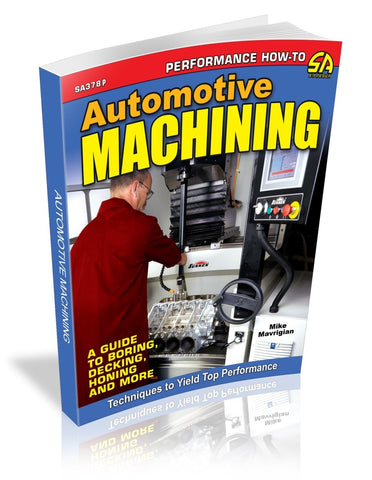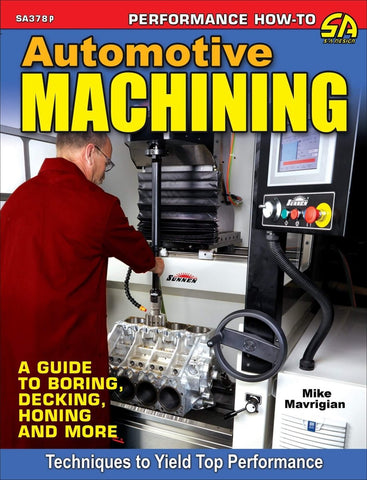The photos in this edition are black and white.
Maximize the potential of your engine build by using the automotive machining procedures, including cylinder boring, align boring/honing, decking, valve seat cutting, cam tunnel boring, and much more.
A detailed, authoritative, and thorough automotive engine machining guide for the hard-core enthusiast has not been available until now. Mike Mavrigian, editor of Engine Building Professional, walks you through each important machining procedure. A stock 300-hp engine build has far different requirements than a 1,000-hp drag race engine, and Mavrigian reveals the different machining procedures and plans according to application and engine design. He also shows you how to inspect, measure, and evaluate components so you can make the best machine work choices. Multi-angle valve jobs, altering rocker arm ratios, re-conditioning connecting rods, and machining and matching valvetrain components are also covered.
Machining is an essential part of high-performance engine building and stock engine rebuilding. Although you may not own the expensive tooling and machining to perform all or any of the machining required for a quality build, understanding the principles, procedures, and goals for machining is vital so you can guide the machining process when outsourced. Classic and older engines typically require extensive machining and almost every major component of engine, including block, heads, intake, crankshaft, and pistons, requires some sort of machining and fitment.
Whether you're an enthusiast engine builder or prospective machining student who wants to pursue a career as an automotive machinist, this book will provide insight and in-depth instruction for performing the most common and important machining procedures.
Acknowledgments
Introduction
Chapter 1: Engine Component Cleaning
Airless Shot Blasters
Hot Tank Cleaning
Jet Spray Cabinets
Cold Solvent Wash
Ovens
Soap and Water
Media Blasting
Soda Cabinet Blasting
Blasting Media
Tumbling and Vibratory Cleaning
Ultrasonic Cleaning
Cleaning with Hand and Power Tools
Chapter 2: Precision Measurement Tools
Micrometer
Dial Indicator
Dial Bore Gauge
Mounting a Bore Gauge with a Setting Fixture
Depth Gauge
Internal Caliper Gauge
Measuring Pushrod Length
Valvespring Height Gauge
Valveseat Runout Gauge
Precision Straightedge
Rod Bolt Stretch Gauge
Torque-Plus-Angle
Ultrasonic Thickness Gauge
Torque Wrenches
Cam Lobe Checker
Chapter 3: Cylinder Block Disassembly and Inspection
Step by Step
Block Inspection
Crankshaft Inspection
Rod Inspection
Cam Inspection
Pushrod Inspection
Rocker Arm Inspection
Cylinder Head Inspection
Chapter 4: Cylinder Block Machining
Rough Edge and Obstruction Deburring
Main Bore Align Honing
Cylinder Boring and Honing
Cylinder Sleeving
Lifter Bore Honing and Bushings
Block Deck Resurfacing
Threaded Hole Preparation
Block Blueprinting
Chapter 5: Crankshaft Measurement, Grinding and Preparation
Measuring the Crankshaft
Selecting the Grinding Wheel
Dressing the Wheel
Straightening the Crank
Grinding and Polishing the Journals
Grinding the Flywheel
Chapter 6: Connecting Rod Inspection and Reconditioning
Inspecting Connecting Rods
Measuring Rod Bore Diameter
Measuring Center-to-Center Length
Checking for Bend and Twist
Reconditioning Connecting Rods
Chapter 7: Pushrods and Lifters
Measuring for Pushrod Length
Chapter 8: Pistons
Measuring Piston Skirts
Checking Ring-to-Piston Fit
Modifying Domes
Checking Valve-to-Piston Clearance
File Fitting Rings
Chapter 9: Cylinder Head Inspection, Service and Machining
Resurfacing the Deck
Measuring Chamber Volume
Installing New Guide Liners
Refacing Valves and Seats
Measuring Valvespring Height
Measuring Valvestem Height
Checking Spring Pressure
Porting Cylinder Heads
Final Assembly
Chapter 10: Engine Block CNC Machining
Milling the Block
CNC Terminology
Chapter 11: Port Machining
Ports and Runners
Verifying and Monitoring with a Flow Bench
Port Matching
Intake Manifold Plenums
Intake Port Surface
Extrusion Honing
Chapter 12: Engine Balancing
Out-of-Balance Forces on the Crank
Connecting Rods
Pistons
Engine Styles
Bobweights
4-Cylinder Inline Engines
Crankshaft
Under- versus Over Balancing
External versus Internal Balancing
Dampeners and Flywheels
Chapter 13: Clearance Checking
Main Bearings
Rod Bearings
Cam Bearings
Cam Thrust
Piston-to-Wall Clearance
Rod Sideplay
Lifter Bore
Crank-to-Block Clearance
Rod-to-Block Clearance
Piston Ring Gap
Crank Thrust
Valve-to-Piston Clearance
Chapter 14: Final Assembly
Cleaning
Cam
Upper Main Bearings
Crankshaft and Rear Seal
Main Caps and Lower Bearings
Pistons and Rods
Timing
Oil Pump and Pickup
Lifters
Heads
Pushrods and Rocker Arms
Intake Manifold
Distributor
Timing Cover, Rear Cover, Oil Pan and Valvecovers
Water Pump
Crankshaft Balancer
The photos in this edition are black and white.
Maximize the potential of your engine build by using the automotive machining procedures, including cylinder boring, align boring/honing, decking, valve seat cutting, cam tunnel boring, and much more.
A detailed, authoritative, and thorough automotive engine machining guide for the hard-core enthusiast has not been available until now. Mike Mavrigian, editor of Engine Building Professional, walks you through each important machining procedure. A stock 300-hp engine build has far different requirements than a 1,000-hp drag race engine, and Mavrigian reveals the different machining procedures and plans according to application and engine design. He also shows you how to inspect, measure, and evaluate components so you can make the best machine work choices. Multi-angle valve jobs, altering rocker arm ratios, re-conditioning connecting rods, and machining and matching valvetrain components are also covered.
Machining is an essential part of high-performance engine building and stock engine rebuilding. Although you may not own the expensive tooling and machining to perform all or any of the machining required for a quality build, understanding the principles, procedures, and goals for machining is vital so you can guide the machining process when outsourced. Classic and older engines typically require extensive machining and almost every major component of engine, including block, heads, intake, crankshaft, and pistons, requires some sort of machining and fitment.
Whether you're an enthusiast engine builder or prospective machining student who wants to pursue a career as an automotive machinist, this book will provide insight and in-depth instruction for performing the most common and important machining procedures.
Acknowledgments
Introduction
Chapter 1: Engine Component Cleaning
Airless Shot Blasters
Hot Tank Cleaning
Jet Spray Cabinets
Cold Solvent Wash
Ovens
Soap and Water
Media Blasting
Soda Cabinet Blasting
Blasting Media
Tumbling and Vibratory Cleaning
Ultrasonic Cleaning
Cleaning with Hand and Power Tools
Chapter 2: Precision Measurement Tools
Micrometer
Dial Indicator
Dial Bore Gauge
Mounting a Bore Gauge with a Setting Fixture
Depth Gauge
Internal Caliper Gauge
Measuring Pushrod Length
Valvespring Height Gauge
Valveseat Runout Gauge
Precision Straightedge
Rod Bolt Stretch Gauge
Torque-Plus-Angle
Ultrasonic Thickness Gauge
Torque Wrenches
Cam Lobe Checker
Chapter 3: Cylinder Block Disassembly and Inspection
Step by Step
Block Inspection
Crankshaft Inspection
Rod Inspection
Cam Inspection
Pushrod Inspection
Rocker Arm Inspection
Cylinder Head Inspection
Chapter 4: Cylinder Block Machining
Rough Edge and Obstruction Deburring
Main Bore Align Honing
Cylinder Boring and Honing
Cylinder Sleeving
Lifter Bore Honing and Bushings
Block Deck Resurfacing
Threaded Hole Preparation
Block Blueprinting
Chapter 5: Crankshaft Measurement, Grinding and Preparation
Measuring the Crankshaft
Selecting the Grinding Wheel
Dressing the Wheel
Straightening the Crank
Grinding and Polishing the Journals
Grinding the Flywheel
Chapter 6: Connecting Rod Inspection and Reconditioning
Inspecting Connecting Rods
Measuring Rod Bore Diameter
Measuring Center-to-Center Length
Checking for Bend and Twist
Reconditioning Connecting Rods
Chapter 7: Pushrods and Lifters
Measuring for Pushrod Length
Chapter 8: Pistons
Measuring Piston Skirts
Checking Ring-to-Piston Fit
Modifying Domes
Checking Valve-to-Piston Clearance
File Fitting Rings
Chapter 9: Cylinder Head Inspection, Service and Machining
Resurfacing the Deck
Measuring Chamber Volume
Installing New Guide Liners
Refacing Valves and Seats
Measuring Valvespring Height
Measuring Valvestem Height
Checking Spring Pressure
Porting Cylinder Heads
Final Assembly
Chapter 10: Engine Block CNC Machining
Milling the Block
CNC Terminology
Chapter 11: Port Machining
Ports and Runners
Verifying and Monitoring with a Flow Bench
Port Matching
Intake Manifold Plenums
Intake Port Surface
Extrusion Honing
Chapter 12: Engine Balancing
Out-of-Balance Forces on the Crank
Connecting Rods
Pistons
Engine Styles
Bobweights
4-Cylinder Inline Engines
Crankshaft
Under- versus Over Balancing
External versus Internal Balancing
Dampeners and Flywheels
Chapter 13: Clearance Checking
Main Bearings
Rod Bearings
Cam Bearings
Cam Thrust
Piston-to-Wall Clearance
Rod Sideplay
Lifter Bore
Crank-to-Block Clearance
Rod-to-Block Clearance
Piston Ring Gap
Crank Thrust
Valve-to-Piston Clearance
Chapter 14: Final Assembly
Cleaning
Cam
Upper Main Bearings
Crankshaft and Rear Seal
Main Caps and Lower Bearings
Pistons and Rods
Timing
Oil Pump and Pickup
Lifters
Heads
Pushrods and Rocker Arms
Intake Manifold
Distributor
Timing Cover, Rear Cover, Oil Pan and Valvecovers
Water Pump
Crankshaft Balancer










